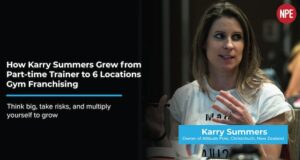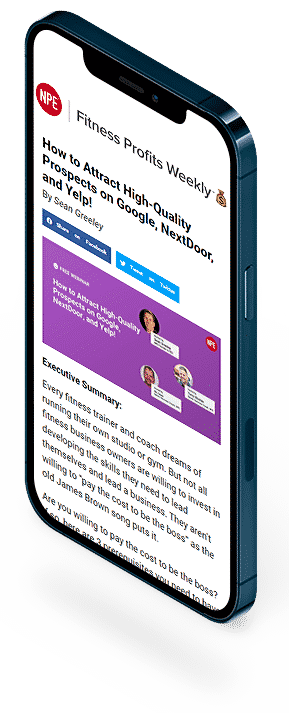How to Overcome Challenges as Gym Owner Without Running Out of Cash
By Sean Greeley

As a business owner, you’re going to run into problems.
It is inevitable. Everyone runs into problems.
It doesn’t matter how smart you are or how successful you’ve been in the past… often things happen outside of your planning or control that will put you and your business in a difficult spot.
When this happens, don’t beat yourself up too bad about it.
Feeling sorry for yourself, moping about, playing the victim role… doesn’t move you forward.
You must first make a decision to change your mindset.
Empathy, gratitude, and love
Problems challenge us emotionally.
And it’s all too easy to become fearful, angry, or upset.
But don’t let that happen to you.
Accept and embrace the challenge. Be grateful for it!
Challenges give us the opportunity to #riseup and grow as business owners and leaders.
They hold within them tremendous growth potential for us.
But first you must replace your judgments with empathy, upgrade your complaining to gratitude, and trade in your fear for love.
Once you’re in the right state of mind (and are ready to begin the work to be done with the right spirit about you), then it’s time to create space for you to…
Think your way out of any problem
I believe that every problem has a solution.
I’ve seen many things and had many experiences in my life that have proven that to be true.
Whatever you’re dealing with… a business challenge… a medical challenge (I fought Stage IV cancer at the age 26 and won)… there is a solution (often many solutions) out there just waiting to be discovered.
You must believe that too, and remember NPE Client Success Principle #2 “have courage, practice faith.”
Then with that faith, you must engage in very clear thinking to clarify the problem, identify solutions, and then determine strategy and a solid plan of action that will lead you (and your team or family) to the other side.
Here are nine steps you can follow to tackle any challenge thrown at you:
Step 1: Clarify the problem
When you’re facing a challenge, there is generally a bunch of issues going on simultaneously.
Lots of ‘symptoms’ that are showing up (all related to the core problem).
And until you’ve clarified your thinking, you must be careful about not wasting precious time and energy flailing about trying to address all of them.
For example, when cash flow gets tight… there can be a ton of challenges including your marketing message, your lack of a defined target market, lack of consistent lead generation activity, staffing issues, perhaps a few clients that weren’t happy with your services and didn’t renew, and more.
All of those things need attention… but where should you start?
Start with creating space to just think.
The more you grow, the more “thinking time” will become the most valuable time invested working ON your business.
Take the emotion out of the situation.
And clarify the problem.
Good business owners learn how to correctly “diagnose” the real problem that is causing all of the negative symptoms.
Then further to that point, you must determine its size and scope.
We use a tool called the Cash Dashboard in our NPE PROGRAM™ that forecasts all cash moving in and out of a business week-by-week for 12 weeks in the future.
And reviewing your cash IS the most important problem that must be focused on.
Running out of cash is like running out of oxygen.
Your business can’t survive without it!
Therefore, clarifying the problem generally involves identifying a financial gap that must be met in order to succeed.
How much of a difference must be made up?
What is the reoccurring revenue gap?
What does the cash dashboard show?
A clearly defined problem looks like this:
“The business currently has a 6,000 per month revenue gap.”
Once you’ve identified the problem, then it’s time to identify how it happened, which is also very important to understand.
Step 2: Identify how it happened
Identifying how a problem occurred always carries tremendous learning and growth opportunities with it.
It’s very hard to learn anything in business (or life) when everything is going right.
When things are going well, you just roll with it. It’s easy!
But when things get tough, this is where you can learn and grow.
Let’s continue running with the example above…
“The business currently has a 6,000 per month revenue gap.”
How did this occur?
- Lead generation activity slowed down (or stopped) because we got pulled away dealing with challenges in other areas of the business
- The marketing activities we did weren’t clearly focused on the right target market
- Our messaging wasn’t effective in calling out to the target market we want to reach
- We stopped networking and building (or maintaining) partner relationships
- We lost an administrative assistant and got pulled back into operations of the business (stealing from time to work on the business)
Ok, now each of those challenges is real. They happen. And they can lead to the problem we’ve identified.
Now that we’ve identified the issues that led to the problem, it’s time to move onto…
Step 3: Set the goal

You’ve got to have a clear goal and target to focus on that will drive your business forward.
In this case, we have a 6,000 a month revenue gap in the business.
But 6,000 is just break even.
For the business to be healthy and have some breathing room… we’re going to want to add more like 10,000 a month in reoccurring revenue in order to not stay up at night worrying about this issue anymore.
So, we’ve got a 10,000 a month goal.
But what does that really mean?
I encourage you to break down the revenue goal further into a client acquisition goal.
If we know the average client is worth 350/month to your business… then 10,000 / 350 = 29 clients.
Now if you know your average close rate, we can back that out into a qualified sales opportunity goal to focus your marketing activity around.
Let’s say your sales process is closing at 80% right now.
In this case, to hit the 29 new clients goal… you’re going to need 36 qualified sales opportunities to put in front of your sales process.
Now we’ve got a clear goal.
Thirty-six qualified sales opportunities, closing at 80% from your sales process, worth an average of 350/month to your business equals 10,000 a month in reoccurring revenue.
That is the target that leads to having your problem solved with some breathing room added on top!
Step 4: Brainstorm strategy to achieve the goal
With a clear target identified, it’s time to transition into strategic thinking.
What’s the best (and fastest) way to generate 36 qualified sales opportunities?
And as with any marketing campaign…
- WHO is your target?
- WHAT is your offer?
- HOW will you communicate to get the offer in front of your target?
NOTE: We don’t have the time to go into the full anatomy of a successful fitness marketing campaign in this article, but I’ll be writing more about that soon on this blog.
When you’re clear on the WHO you’re trying to reach and the OFFER you’re making to bring them in the door, then HOW you’re going to communicate is all about the STRATEGIES you select to drive lead generation.
Advertising
Advertising can be great when it works and painful when it doesn’t.
The pros of this strategy: it’s scalable to reach big numbers, and thanks to online media available today like Facebook, you can test it very inexpensively… then when you have a winning ad… you can scale it up and put more money behind it.
The cons: it takes some financial investment to get going (much less than it used to), and you’ve got to get your targeting, messaging, and offer right to engage the right prospective clients.
All in all though, when you get advertising right, it can produce a tremendous amount of leads for your business virtually overnight.
We’ve worked with many clients who were struggling with lead generation, and within a couple days of launching a new advertising campaign, they suddenly had more leads than they could handle.
So, assuming your target market is on Facebook (at Facebook’s current stats of 1.44 billion users and counting, this is probably a safe bet) then this is a great place to go fishing for new prospective clients.
Social Media
Social media (more than just Facebook advertising) is also an incredibly powerful tool.
Not just for direct lead generation, but perhaps more importantly for building your brand and community.
Photos, video, other posts and engagement help people get to know, like, and trust your business before they’ve walked through your tools.
And by engaging your current clients in the process, you get to build stronger relationships with them while you get to be positioned in front of their friends and family at the same time.
In short, have fun with this. Social media (and all your marketing) should be fun.
Client Referrals
Client referrals are a great way to grow quickly. And when done right, a good referral campaign can include social media marketing (as listed above).
Some quick notes on referral marketing: There is a big difference between word of mouth and referral marketing.
Word of mouth I call a “hope” strategy. You ‘hope’ others will say nice things about you and refer clients your way.
But hope is never a good strategy in business or in war.
You must have a clear plan and action steps to ensure your success.
Another tip to share here is that when you have a good offer that’s working in your advertising, don’t try to re-invent the wheel. Just work with your clients to drive more good quality prospects into the same winning offer!
Networking/Partnerships
Networking and partnerships are in most cases low cost, high impact marketing strategies.
Especially in local marketing service-based businesses.
You must be known in your market for being the best at what you do.
And that will never happen through advertising alone.
Building relationships with other key local business leaders and other health and wellness providers in your area is essential to “own” the top positioning in the market.
And your partner network can scale lead generation dramatically through all kinds of activities and campaigns including direct marketing, social media, public speaking, and more.
Step 5: Target and plan to move forward with each strategy
Now that you’ve identified your key strategies, it’s time to align your goals with each strategy.
If we need 36 qualified sales opportunities, how many can you get from advertising?
How many from social media?
How many from partners/networking?
You must set some goals and targets for each strategy.
What’s the right goal to set for each?
Only you can make that call… but with some review of your historical marketing activity and results… and some good advice from a coach with experience in this area… you’ll learn how to set some reasonable ones.
Just plan on doing what is required to get more than you need.
And focus each strategy on getting your OFFER in front of your TARGET with as much efficiency as possible.
In this example, I’m going to go with:
Advertising – 18 qualified sales opportunities
Social Media – 4 qualified sales opportunities
Client Referrals– 8 qualified sales opportunities
Partners/Networking – 10 qualified sales opportunities
40 total qualified sales opportunities exceed our goal of 36.
That’s a reasonable plan with good targets you can move forward with.
Step 6: Assign owners to each strategy
If you’re the only one working on solving this problem, that’s not a whole lot of fun.
Find others you can enroll in supporting the process.
This is how you grow and develop leaders in your organization.
Give them some responsibility, and support them in owning the strategy and hitting the target.
Especially if you’ve got three or four strategies you’re working with… you’re going to need the help.
If you don’t have others that can own the targets with you, then you may need to simplify this process and only focus on one or two strategies.
But that generally means you’ve also got a smaller business and will therefore need less qualified sales opportunities, so you’ll be fine.
It’s better to crush one or two strategies than be spread too thin and execute them all weakly.
Commit to a position of strength (it’s a fine line between taking on too much and taking on too little) and go smash it out!
Step 7: Break goal from monthly into weekly, daily targets
You’ve got targets, but it’s time to break them down into weekly and daily numbers.
You (and your team) must wake up each day and know the numbers that must be reached.
Make it very clear for everyone involved what must be done.
And commit to relentless execution.
If the goal is two today, and it gets missed… then tomorrow it’s four.
Laser-like focus is required when it’s go time.
If you’re networking and need to identify a new partner… go out with a hit list of people to visit, and don’t come home until it’s done.
Step 8: Daily stand up and reporting
Realigning yourself and your team each day is critical when you’re working through a big challenge.
Conditions and variables will change.
And you must adjust, adapt, and overcome new challenges that arise accordingly.
It’s also critical to take time and celebrate what’s going right.
There is ALWAYS something going right. And that positive focus and energy is powerful for you and your team to keep on fighting the challenges you’re facing!
Here’s a good format I recommend for daily stand up meetings (and yes, have a meeting with yourself using this agenda too if you’re flying solo here).
- Positive focus – Take a few moments to focus on and celebrate what’s going right.
- Key metrics – Where are you at with hitting targets? What’s the actual number you’ve achieved vs. the goal?
- Plan to achieve metrics – What’s your plan to hit your targets? What’s next in executing your plan?
- Obstacles to achieving metrics – What roadblocks are standing in your way? Where are you stuck in moving forward with your plan? How will you adapt and overcome those obstacles?
Don’t skip the meeting rhythm. Keep it going daily (ideally at the same time each day) and keep working through each item as needed until you conquer the problem!
Step 9: Still stuck? Reach out for help!
Here’s the good news.
Any challenge that you face in your business (or life), someone else has faced and overcome it before.
You’ll save yourself loads of hassle and energy by simply finding coaches, mentors, and friends that are further along the journey than you are in growing your business.
Ask them how they overcame the challenges you’re dealing with.
Then listen to them.
You’ll learn a lot by asking the right questions and listening to the answers.
After 9 years, and over 21,479+ clients served in 94 countries… we’ve got a ton of experience in tackling big problems.
Growth Opportunity
No matter how hard it gets, or how difficult the problem you’re facing may seem… always remember that every challenge holds within it tremendous opportunity for personal (and professional) growth and development (regardless of the short term outcome).
The greater the conflict, the more glorious the triumph!
So take a deep breath, break big things down into smaller “chunks,” and just focus on taking the next right step forward.
You never know what’s just around the corner, or how things will change that you simply can’t see or anticipate right now.
And don’t forget to reach out for help when you need it.
One of the best lessons I’ve ever learned from facing big challenges (and tackling major problems) is to let go of my ego.
You don’t need to have all the answers, and there is no shame in asking others for guidance and support when you need it.
Everyone who’s made it to the top has conquered numerous challenges along the way. And the most successful people I know all have had mentors and coaches who’ve helped them get there.
Keep a positive state of mind and spirit about you, have courage, practice faith, and keep going until the battle is won!














